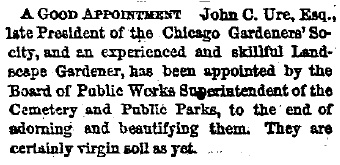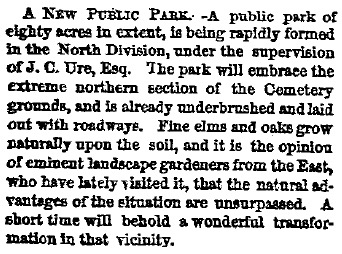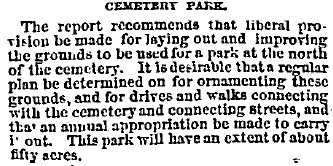|
The earliest reference I found that suggested changing the City Cemetery location into a pleasure ground was in the Chicago Daily Democrat Press newspaper. During the summer months of 1855, this publication printed editorials and letters to the editor referencing the ill-considered location of the cemetery, and the need for a park on the lake. Although the published items reference a petition that was presented to the Common Council, I did not find such a record within the official city files. The Chicago Tribune did not publish any communication regarding this group of citizens and their ideas about the cemetery grounds. This was was four years before Dr. John H. Rauch published his first paper regarding the health concerns of the urban cemetery on the lakeshore. The citizen's petition did not affect any reorganization of the landscape.
______________________________________________________________
|
Chicago Daily Democrat Press, June 22, 1855
The Cemetery Park on the North Side
Among reflecting men who understand the subject it can scarcely be doubted that the site for the Cemetery is badly chosen. Not that the ground is badly located but it is but several miles too near the city. In fact it is within the city, and the residences of our citizens are already built far beyond it. The impropriety, we might say absurdity, of having the principal cemetery only a mile or a little more from the centre of a large city, must be apparent to any one who lays claim to any ordinary degree of intelligence.
It is perhaps too late to remove all those who have been interred in the cemetery, but it seems to us that no more lots should be sold north of those already used for interment. The title to the lands already purchased by individuals could not be affected, but it would be very easy to sell no more.
The question arises what shall be done with the lands still in the hands of the city? We will state our plan, and if any one can propose a better it shall have our cordial support.
We learn that there are about fifty acres in one of the quarter sections in the enclosure which is not yet occupied. Let this be set apart for a park; throw the refuse street dirt on it for a year or two, which would enrich the soil, play it out with trees and lay out walks through it in every direction, and in ten years it will be the pride of the city. Being on the lake shore it would be a source of health and pleasure to our citizens whose real value could scarcely be estimated in money.
North of this the city has nearly sixty acres on the lake shore. Lay this off in blocks of from one to two acres and we should not be surprised if it would bring one hundred and twenty thousand dollars. This would furnish the city with ample means to purchase a mile square or more if necessary at Blue Island or Oak Ridge, eight miles West of the city. Perhaps some better location can be found, and if so, let it be chosen; but in our humble judgement something should be done at once in a matter so important to the best interests of the city. Will our city fathers examine this subject.
_____________________________________________
|
Chicago Daily Democrat Press, June 26, 1855
The Cemetery Park on the North Side
I read with much pleasure the remarks under the above heading in your paper of the 22d just. The ground indicated, lying as it does upon the Lake Shore, is admirably adapted to the purpose of a public park, and the progress of the city in that direction demonstrates very closely that should it be occupied for cemetery purposes, the ashes of the dead, however much to be lamented, will sooner or later be disturbed.
All now admit that a great mistake was made in selecting a site for a cemetery so near the centre of the city. But this error may in part be turned to good account if the unoccupied portion of these grounds cannot of course be interfered with, but the northern portion embracing some fifty acres is still under the control of the city authorities. Every one it seems to me who has the future welfare of the city at heart will say with you let the further sale of this ground for cemetery purposes be stopped and the necessary steps be taken for appropriating it for a Public Park.
A better geographical position for a Park on the lake shore in the North Division could not be chosen. Long ere our city reaches its maximum size it would be centrally situated in the Division. The man who secures such a breathing place on the shore of our noble lake will merit and receive the blessings of posterity. A.B.
****************
The above communication is from one of our most intelligent citizens and far-seeing businessmen. We are glad that our views are seconded from such a quarter. We should be glad to hear from other citizens on this subject, and what would be still better, to see the subject brought prominently before the Council. Who will take time to get up petitions? Who to circulate them? We cannot see any valid objection to the proposition. Let us have one respectable park on the lake shore.
*****************
|
In 1861, John C. Ure was hired as a landscape gardener, and was appointed the Superintendent of the City Cemetery. Ure's responsibility's extended to the management of all established city parks. The following year, the eighty acres of unused cemetery grounds were reconfigured as a park. The City Cemetery was filled beginning at North Avenue, and continued to be developed northward through the years. As each subdivided section was filled, another survey established a new section of the cemetery. |
Chicago Tribune, May 13, 1861

Chicago Tribune, September 5, 1861

|
Chicago Tribune, May 6, 1863
 John C. Ure wrote this in the Board of Public Works, Annual Report in 1863:
John C. Ure wrote this in the Board of Public Works, Annual Report in 1863:
“We have trimmed the trees in the northern part of the cemetery, generally known as the park; planted a row of maple trees along the first road by the fence on the west side; which are all alive and doing well. About six months ago a large portion of the fence of the cemetery was blown down and damaged by a strong wind, and we have repaired it as well as possible under the circumstances. A portion of the fence on the east side of the cemetery was almost covered by drifted sand. The boards of this fence being rotten, we considered it best not to raise it, but put new boards above the old ones where the sand had covered them."
|
________________________________________________________________________
Burials continued in the City Cemetery until 1866. Apparently John Ure was kept busy managing the graveyard and maintaining the other developing parks in the city, because two years later the Chicago Tribune said this:
Chicago Tribune, March 27, 1864
The Cemetery Park
There is an ordinance before the City Council for the improvement of the tract of land known as the Cemetery Park, comprising about fifty acres, lying north of the Chicago cemetery. It is proposed to dedicate and improve it as a public park. … Cemetery Park is admirably adapted to the purpose for which we hope it will be dedicated, being covered with a beautiful growth of timber, lying on the lake shore and of easy access from the city. Very little has hitherto been done for the improvement of this portion of the city, and we trust the small expense necessary to make this beautiful piece of ground a health-giving place of resort to our citizens, instead of a weed-grown wilderness, as it now is, will be appropriated cheerfully by the Council.
_______________________________________________________________________
In 1865, Cemetery Park became Chicago's second-named Lake Park. Nine months later, after the assassination of President Lincoln, the park was named in his honor. Lincoln Park, like the earlier named park grounds, covered the area from Wisconsin Street north to Asylum Place (now called Webster Avenue.)
In September 1865, Swain Nelson was hired as Lincoln Park's first landscape gardener. Listen to a conversation with Julia Bachrach, the Chicago Park District Historian, about the early landscape designs of Swain Nelson, here.
By the time the 1866 disinterments began in the Milliman Tract, seriousl consideration was being given to remove the graves from the rest of the cemetery and to incorporate those grounds into Lincoln Park. Ultimately, the sanitary concerns did not seem to be an urgent reason to remove the graves. The Lincoln Park Commissioners did not have the monetary resources to fund the disinterments and there was also resistance from some cemetery lot holders. During this time, the grounds north of the cemetery were being developed as Lincoln Park and the graveyard became known as the Old Cemetery. No additional burials were allowed, and the burial grounds were described as neglected.
After the Milliman Tract was vacated of graves, and the land was returned to the Milliman heirs, that twelve-acre plot stood isolated as privately held land. It was not incorporated into the park until after the 1871 Chicago Fire, when all cemetery lots were condemned and the tract was acquired by the Lincoln Park Commissioners. See the Miiliman Tract area and subdivisions, here.
When the Chicago Fire reached Lincoln Park, its northernmost destination, the flames passed through the City Cemetery. Apparently, many grave markers were made of wood and were destroyed in the fire. This is undoubtedly one of the reasons that bodies from the cemetery were left behind in Lincoln Park. I learned from my conversations with David Keene, the archaeologist who led the 1998 excavation for the Chicago History Museum's parking facility, and Dawn Cobb, an archaeological research associate at the Illinois State Museum, that a missing marker is the primary reason graves become lost, and then forgotten.
After the fire ravaged the cemetery grounds (see narrative accounts of the Chicago Fire that involve the cemeteries on the lakeshore, here), as part of the cleanup effort, the City Cemetery slowly disappeared from the landscape. In 1872, disinterments began in earnest, and in 1874, the Lincoln Park Commissioners condemned the seven hundred and twelve burial lots that had not been emptied of their graves. If filled, seven hundred and twelve lots could have held more than five thousand bodies.
On February 18, 1877, the Chicago Tribune wrote: "With the completion of the present work, every vestige of the old cemetery will have disappeared except Couch's tomb."
The Couch Tomb remains on the spot where it was built in 1858, making it the oldest structure still standing within the Chicago Fire zone. |
|

